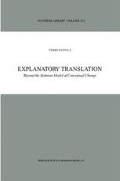Abstract
In Chapter 3 nonstandard translation was studied in the local sense. When scientific theories and literary works are translated, possible situations and languages must be explored more globally. In the present chapter, I generalize the earlier ideas about local translation by studying a global version (concerning literary works) of what was in Chapter 2 called explanatory translation. The notion will cover, as earlier, both translations between two languages and paraphrases. The generalization will be rather immediate, and it will gradually lead us to the definition of correspondence relation, which is considered in Chapter 5, below. Recall, however, that what is here taken as the notion of translation is not strict enough to satisfy Kuhn (1983).
Access this chapter
Tax calculation will be finalised at checkout
Purchases are for personal use only
Preview
Unable to display preview. Download preview PDF.
Notes
See, e.g., Lewis (1978); Pavel (1978); Rantala and Wiesenthal (1989); Rosen (1994).
When it is said, for example, that an expression (with whatever illocutionary force) is satisfied at a world, it means roughly the same as before. See Section 2.3 for the discussion of the difficulties involved in the definition of the speaker’s situations. For example, in some contexts, we may even let the hearer choose the speaker’s worlds if that is epistemologically grounded. To speak of actual worlds is, of course, also problematic; they are worlds which the reader thinks are correct, given the text, its translation, context, etc. Thus the notion does not necessarily mean here the same as in possible worlds semantics in general.
Later on, in Section 4.4, when studying narrative texts as sequences of sentences, I return to situations, referring to them as local components of worlds corresponding to events described by individual sentences.
For a thorough discussion of this issue, see, e.g., Lewis (1978); Rantala and Wiesenthal (1989).
See my (1987) and (1988b).
For problems involved, see Oesch and Rantala (1999). One way to try to distinguish between what literary theorists call reception and interpretation is to argue that a reception is the emergence of the reader’s courses of events when he or she is reading the text, but an interpretation includes, but is not exhausted by, the construction of worlds. Then we can see a little more exactly in what way reception is the logical basis of interpretation.
It is not assumed here, as Goodman (1968) does, that only things that exist can be denoted. This means that the term is here assumed to apply to narrative fictions as well.
For the principle, see Section 2.1.
But they do not accept such evidence.
According to a common view, literary works do not usually have a unique meaning. It would not even be desirable since the existence of many meanings is considered aesthetically and cognitively valuable in artworks.
See Rantala and Wiesenthal (1989) for a more comprehensive discussion.
Op. cit., pp. 64, 66–68. It is a simple model-theoretic fact that, generally, the less there are worlds (models) the more truths they admit of.
See Lewis (1978), p. 45, for a more detailed analysis of truth in fiction.
Wolterstorff (1980), p. 121.
There is one in Rantala and Wiesenthal (1989), pp. 77–79.
For arguments defending the import of authors’ intentions and for an overview, see also Haapala (1989).
See Rantala (1987); and from a semiotic point of view, Eco (1979).
Borges (1962). See my (1987).
Hence the ideal reader could be considered as a ‘hermeneutic limit’ of an ordinary reader.
Here we would then have another example of the back-and-forth character of reading.
Author information
Authors and Affiliations
Rights and permissions
Copyright information
© 2002 Springer Science+Business Media Dordrecht
About this chapter
Cite this chapter
Rantala, V. (2002). Global Translation. In: Explanatory Translation. Synthese Library, vol 312. Springer, Dordrecht. https://doi.org/10.1007/978-94-017-1521-8_4
Download citation
DOI: https://doi.org/10.1007/978-94-017-1521-8_4
Publisher Name: Springer, Dordrecht
Print ISBN: 978-90-481-6105-8
Online ISBN: 978-94-017-1521-8
eBook Packages: Springer Book Archive

